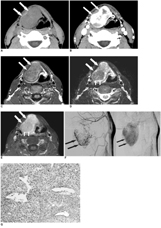Korean J Radiol.
2008 Dec;9(6):568-571. 10.3348/kjr.2008.9.6.568.
CT, MR, and Angiography Findings of a Solitary Fibrous Tumor of the Larynx: a Case Report
- Affiliations
-
- 1Department of Radiology, Kangdong Seong-Sim Hospital, Hallym University College of Medicine, Seoul, Korea. chkcsk@empal.com
- 2Department of Pathology, Kangdong Seong-Sim Hospital, Hallym University College of Medicine, Seoul, Korea.
- KMID: 1118881
- DOI: http://doi.org/10.3348/kjr.2008.9.6.568
Abstract
- This report details the CT, MR, and angiography findings of a solitary fibrous tumor involving the larynx of a 34-year-old man. A precontrast CT scan revealed a well-defined isodense mass in the submucosal region of the supraglottic larynx. The tumor appeared as a mixed intensity lesion on the T1- and T2-weighted MR images. A T2-weighted MR image showed a central, round, and low signal intensity area within the mass. For both the CT and MR images, the mass demonstrated heterogeneous enhancement following the administration of contrast material. The angiography showed a hypervascular tumor with heterogeneous persistent staining.
Keyword
MeSH Terms
Figure
Reference
-
1. Kim TA, Brunberg JA, Pearson JP, Ross DA. Solitary fibrous tumor of the paranasal sinuses: CT and MR appearance. AJNR Am J Neuroradiol. 1996. 17:1767–1772.2. Jeong AK, Lee HK, Kim SY, Cho KJ. Solitary fibrous tumor of the parapharyngeal space: MR imaging findings. AJNR Am J Neuroradiol. 2002. 23:473–475.3. Kim HJ, Lee HK, Seo JJ, Kim HJ, Shin JH, Jeong AK, et al. MR imaging of solitary fibrous tumors in the head and neck. Korean J Radiol. 2005. 6:136–142.4. Dunfee BL, Sakai O, Spiegel JH, Pistey R. Solitary fibrous tumor of the buccal space. AJNR Am J Neuroradiol. 2005. 26:2114–2116.5. Benlyazid A, Lescanne E, Lefrancq T, Fetissoff F, Beutter P. Solitary fibrous tumor of the larynx: report of a case. J Laryngol Otol. 1998. 112:286–289.6. Fan CY, Van Hemert RL, Thomas JR, Breau RL. Atypical solitary fibrous tumor of the larynx. Otolaryngol Head Neck Surg. 2006. 134:880–882.7. Dotto JE, Ahrens W, Lesnik DJ, Kowalski D, Sasaki C, Flynn S. Solitary fibrous tumor of the larynx: a case report and review of the literature. Arch Pathol Lab Med. 2006. 130:213–216.8. Alobid I, Alós L, Maldonado M, Menéndez LM, Bernal-Sprekelsen M. Laryngeal solitary fibrous tumor treated with CO2 laser excision: case report. Eur Arch Otorhinolaryngol. 2005. 262:286–288.9. Stomeo F, Padovani D, Bozzo C, Pastore A. Laryngeal solitary fibrous tumor. Auris Nasus Larynx. 2007. 34:405–408.10. England DM, Hochholzer L, McCarthy MJ. Localized benign and malignant fibrous tumours of the pleura. A clinicopathologic review of 233 cases. Am J Surg Pathol. 1989. 13:640–658.11. Alawi F, Stratton D, Freedman PD. Solitary fibrous tumor of the oral soft tissues: a clinicopathologic and immunohistochemical study of 16 cases. Am J Surg Pathol. 2001. 25:900–910.12. Liang GS, Loevner LA, Kumar P. Laryngeal rhabdomyoma involving the paraglottic space. AJR Am J Roentgenol. 2000. 174:1285–1287.
- Full Text Links
- Actions
-
Cited
- CITED
-
- Close
- Share
- Similar articles
-
- Solitary Fibrous Tumor of the Adrenal Gland: A Case Report
- An Ancillary CT Finding of Intrapulmonary Solitary Fibrous Tumor: A Case Report
- Solitary Fibrous Tumor of the Pancreas: Imaging Findings
- Imaging Findings of a Solitary Fibrous Tumor in Pancreas: A Case Report
- Myxoid Solitary Fibrous Tumor of the Retroperitoneum: MRI Findings with the Pathologic Correlation


